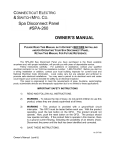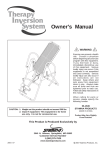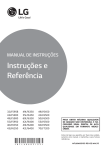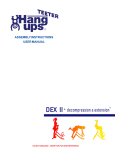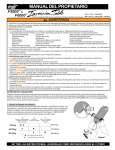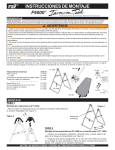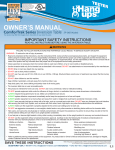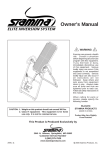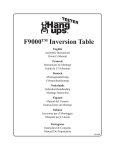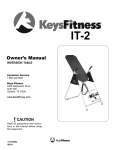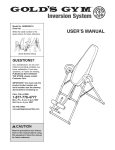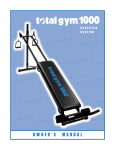Download OWNER`S MANUAL
Transcript
OWNER'S MANUAL F7000 TM U.S. and foreign patents apply. Other foreign patents pending. ! Height / Weight Capacity: Max 6'6" / 300 lbs. (198 cm, 136 kg) WARNING It is your responsibility to familiarize yourself with the proper use of the equipment and the inherent risks of inversion, such as falling on your head or neck, pinching, entrapment or equipment failure. FAILURE TO FOLLOW INSTRUCTIONS OR HEED WARNINGS COULD RESULT IN SERIOUS INJURY OR DEATH. Restrictions on Use • DO NOT use the equipment without a licensed physician's approval. Carefully review the following list of medical contraindications for inversion with your licensed physician: (This is not an exhaustive list, it is intended only for reference) · · · · · · · Middle ear infection Extreme obesity Pregnancy Hiatal hernia Ventral hernia Glaucoma Retinal detachment · · · · · · · Conjunctivitis High blood pressure Hypertension Heart or circulatory disorders Spinal injury Cerebral sclerosis Acutely swollen joints · · · · · · Recent stroke or transient ischemic attack Bone weakness (osteoporosis) Recent or unhealed fractures Medullary pins Surgically implanted orthopedic supports Use of anticoagulants (including high doses of aspirin) • DO NOT use if you are over 6'6" (198 cm) or 300 lbs. (136 kg). Structural failure could occur or head/neck may impact the floor during inversion. • DO NOT modify the equipment or use accessory attachments that are not recommended by the manufacturer. Utilize the equipment for its intended purpose only. • This product is not intended for use in public facilities. Precautions Before Using • DO NOT use the inversion table until you have thoroughly and carefully read the Owner's Manual, viewed the Instructional Video, reviewed all other accompanying documents, and inspected the equipment. • NEVER allow children to use the equipment unsupervised. • DO NOT operate equipment while under the influence of drugs, alcohol, or medication that may cause drowsiness or disorientation. • ALWAYS inspect the equipment prior to use. Make sure that all fasteners are secure and that the equipment is located on a level surface. • ALWAYS replace defective components immediately and/or keep the equipment out of use until repair. • ALWAYS wear securely tied lace-up shoes with a flat sole, such as a normal tennis style shoe. DO NOT wear shoes with thick soles, boots, high-tops or any shoe that extends above the anklebone. • ALWAYS make sure the equipment is properly adjusted to the correct user settings prior to each use. • Refer to additional warning notices posted on the equipment. Precautions during use • DO NOT use aggressive movements, or use weights, elastic bands or any other exercise or stretching device while on the inversion table. • ALWAYS keep hands and fingers away from moving parts to avoid injury. DO NOT drop or insert objects into any opening. • First time users should use a spotter to ensure they are able to find the correct balance setting and are comfortable with the operation of the table. PRIOR TO USE Make sure that the table rotates smoothly to the fully inverted position and back, and that all fasteners are secure. Make sure the user settings described below are properly adjusted for your unique needs and body type. Take your time finding your proper settings and REMEMBER THEM. Check these settings every time prior to using the equipment. 1. Adjust the Roller Hinge: The roller hinge setting controls the responsiveness or rate of rotation. There are three holes; hole selection depends both on your body weight and the rotational responsiveness you desire. For users just learning to use the inversion table, we recommend starting with Setting C. (See Figure 1) IMPORTANT: Place the roller hinges in the same hole setting on each side. A B C Figure 1 D O N O T R E M O V E F R O M TA B L E 2. Adjust Height Setting: The height settings are stamped on the main shaft in both inches and centimeters. • Loosen the de-rattler knob. • Pull out the height selector locking pin with your right hand while sliding the main shaft with your left. (See Figure 2) • Slide the main shaft until the last setting you can read is 1" more than your height. e.g. If you're 5'10" (178 cm) the last numbers you'll be able to read will be 5'11" (180 cm). NOTE: The best height setting for you will depend on your weight distribution and could vary one or two inches on either side of your actual height. Starting at one or two inches more than your Hook tether height will help to ensure that the rotation of the table is not too fast. strap here. • Release the height selector locking pin so that it fully engages in a hole. Retighten 60°° the de-rattler knob. 40° 3. Attach Tether Strap: blue For first time users, attach the tether strap to help control your angle of rotation. (See Figure 3) You can increase the angle of rotation allowed by the tether strap as you become more comfortable using the table, or remove it all-together for full inversion. 20° Figure 2 green No Strap: 90°° Figure 3 4. Adjust Foot Platform: Adjust the foot platform so that when standing on it the foam ankle clamps will secure down onto the smallest part of your ankles, immediately above the anklebone (carefully read the "Mounting and Securing Your Ankles" section below). Properly adjusting the foot platform will help to ensure the most secure hold while you invert. MOUNTING AND SECURING YOUR ANKLES 1. Preparing to Mount: • ALWAYS wear securely tied lace-up shoes with a flat sole, such as a normal tennis style shoe. DO NOT wear shoes with thick soles, boots, high-tops or any shoe that extends above the anklebone, as this type of footwear could interfere with properly securing your ankles. • Confirm that the foot platform is adjusted properly so that the ankle clamps fit snug against the smallest part of the ankle, immediately above the anklebone. 2. Mounting: • Stand on the foot platform, sliding your ankles between the foam ankle clamps. Figure 4 • Press your ankles back firmly against the rear ankle clamps. • Rotate the top of the rear clamps slightly inward toward your ankles - this will increase your comfort while inverting. • Pull out the locking pin to allow the front ankle clamps to snap closed against your ankles. Make sure your pant legs do not interfere with obtaining a secure closure. • Adjust the front ankle clamps to make sure both the front and rear ankle clamps are snug against your ankles. (See Figure 4) Release the locking pin so that it fully engages a hole setting. (See illustrations below) • If the locking pin does not automatically engage in a hole, push the front ankle clamps inward until the pin engages fully in the next tightest hole setting. Verify that no part of the footwear or garments can touch or interfere with the locking pin in any way during inversion. ! WARNING Failure to engage the ankle locking pin fully could result in serious injury or death! DO NOT deviate from these instructions. • Use the concept of HEAR - FEEL - SEE every time you secure your ankles: HEAR the locking pin click into place. FEEL the locking pin to make sure it is fully engaged in a hole setting. SEE that there is NO space between the locking pin and its base. CORRECT: LOCKING PIN FULLY ENGAGED Owner's Manual DANGER: LOCKING PIN NOT FULLY ENGAGED LF7200 Pg. 2 ! WARNING For your first few inversion sessions, ask a spotter to assist you until you are able to find your correct balance setting and are comfortable with the operation of the table. BALANCING Figure 5 The inversion table is like a sensitively balanced fulcrum. It responds to very small changes in weight distribution. As a result, you must always test to make sure you have the correct height setting. Ensure that there is clearance to rotate without contacting other objects or people. Correctly Balanced • Rest your head on the nylon mat and place your arms at your side. Slowly place your arms on your chest. ⇒ If your head is lower than your feet, lengthen the height setting by one hole and test again. ⇒ If your feet do not move at all, then shorten the height setting by one hole and test again. ⇒ If the table comes to rest with your feet lifted a few inches off the A-frame, you have found the correct balance setting! (See Figure 5) The correct balance setting will allow your arm movements to rotate the table backward smoothly and slowly and to return to the full upright position. This is an important step, so you should spend as much time as you need to find your ideal height setting. Once you do find your setting, it should remain the same as long as your weight does not change substantially. Do not use the hand grips to rotate the table. They are for mounting and dismounting; they are not a substitute for finding your correct balance setting. INVERTING Review the insert " Important Details Regarding Inverting" If correctly balanced, the inversion table will operate much like a teeter totter. By shifting weight to the head end of the table, you will move in that direction, and vice versa. Your arms will provide most of the weight needed to rotate the table. Fastening the tether strap before you start will prevent the table from inverting completely. (See Figure 6) Figure 6 • Raise one arm slowly up and over your head, stopping along the way as required to control the downward rotation of the table. If you raise both arms, the speed and angle of inversion increases. • When the table is at an angle you like, rest your arm on the table at whatever position it's in. RETURNING UPRIGHT • To return to the upright position, put your arms at your side. (See Figure 7) Since your body may have lengthened, arm movements alone may not be sufficient to return you to the full upright position. You may need to bend your knees to shift your body weight to the foot side of the pivot point. Do not lift your head or try to sit up. (See Figure 7A) Figure7A FULL INVERSION Figure 7 Bend Knees Slightly Definition: Hanging completely by your ankles with your back free from the table. Do not attempt this step until you are comfortable with partial inversion. • Disconnect the tether strap. • Set roller hinges in the top hole setting "A" if you want the table to "lock" firmly while inverted. If you are 220 lbs. (100 kg) or more, set the roller hinges in the "B" hole setting. • From a balanced position on the table, slowly raise both hands over your head to begin rotation. You may need to assist the last few degrees of rotation by pushing on the floor or A-frame until the table pulls away from your back. In your correct balance setting, your weight will keep the table "locked" in this position until you are ready to return upright. (See Figure 8) Owner's Manual Figure 8 LF7200 Pg. 3 ! WARNING - Tipover Hazard The equipment is structurally rated at a capacity of 6'6" (198 cm) or 300 lbs (136 kg). However, please confine all inverted activities to smooth movements. Aggressive exercises, which involve a lot of body movement, can cause the table to tip over resulting in serious injury or death! To Release from the Inverted "Locked" Position: • Place one hand over your shoulder and hold onto the corner of the table frame. • Place your other hand on the bottom bar of the A-frame in front of you. (See Figure 9) • Pull both hands together. This will rotate the table out of the "locked" position. Slowly move your arms and elbows to your sides to complete the rotation. Elbows protruding over the sides of the table bed could get pinched between the A-frame and the table bed as you return upright (See Figure 9A). • Figure 9 If your body is stretched, you will need to bend your knees to shift body weight to the foot side of the pivot point. Do not lift your head or sit up while releasing from the "locked" position. Figure 10 Figure 9A STORING THE INVERSION TABLE Storage • Loosen the de-rattler knob. • Pull out the main shaft locking pin and slide the main shaft in all the way to the ankle clamp assembly. Allow the locking pin to engage in the storage setting. • Rotate the table opposite from use until the table has turned 180 degrees and rests against the cross bar on the A-frame. • Fold the legs of the A-frame base together for compact storage. (See Figure 10) Take care not to pinch your fingers. ! WARNING It is your responsibility to familiarize yourself with the proper use of the equipment and the inherent risks of inversion, such as falling on your head or neck, pinching, entrapment or equipment failure. DO NOT use the inversion table until you have thoroughly and carefully read the Owner's Manual, viewed the Instructional Video, reviewed all other accompanying documents, and inspected the equipment. ALWAYS test and inspect the equipment for smooth operation prior to each use. For additional languages in Spanish, French, Dutch, German, Italian or Portuguese, please contact customer service. Classified as Medical Equipment, part I in accordance with UL 2601-1 and CAN/CSA C22.2; General Requirements for Safety in accordance with Underwriters Laboratories, Inc. * any modification to this device will void the UL Classification For information about the Teeter Hang Ups® 5-year warranty, or if you have any problems assembling the equipment or questions about its use, please contact Customer Service at the appropriate location below: USA & Canada: STL International, Inc. 9902 162nd St. Ct. E., Puyallup, WA 98375 Toll Free (Phone) 800-847-0143 (Fax) 800-847-0188 Local (Phone) 253-840-5252 (Fax) 253-840-5757 (email) [email protected] (web) www.STLIntl.com International: U.S. and foreign patents apply. Other foreign patents pending. Teeter Hang Ups® is a registered trademark of STL International, Inc. and Inversion International, Ltd. Specifications subject to change without notice. © COPYRIGHT 2005, STL International, Inc. International Law Prohibits Any Copying, 12/04-11 Owner's Manual Inversion International, Ltd. PO Box: AP 59245, New Providence Island, Bahamas (Phone) +1-242-362-1001 (Fax) +1-242-362-1002 (email) [email protected] (web) www.InversionInternational.com LF7200 Pg. 4 IMPORTANT DETAILS REGARDING INVERTING Begin Slowly: • Invert only 15 - 20 degrees to begin with. The hand grips feature engravings that illustrate the body position at 0°, 30°, 60°, & 90°. • Stay down as long as you are comfortable, even if only a few seconds at first. Pay Attention to What Your Body Tells You: • Remind yourself that your body is unique and it will tell you what is good for it. • Come up slowly, dizziness after a session is a sign that you have come up too fast. Important: rest at horizontal for 30 seconds or more, allowing your body to readjust to being upright. • Wait for a while after you've eaten before you invert. • If inversion makes you nauseous, don't fight it. Come up as soon as you feel queasy, even if after only a few seconds. Give it time--it may take weeks or months before your inner ear gets used to inverting. Make Changes Gradually: • Increase the angle in small increments only if it is comfortable to you. You can gain all the benefits of inversion without ever inverting beyond 60 degrees. Muscle stretching and relaxation can be realized at as little as 20 degrees. • You may want to increase your routine from 1-2 minutes to 5 or more over time - just listen to your body. Remember, this is not a no pain, no gain situation! Moving While Inverted is Helpful: • Add gentle stretching and light exercises only after you are comfortable with inversion. Movement while inverted may help make inversion a more comfortable experience and may help joints to realign and muscles to stretch and relax. • Movement may be accomplished either by intermittent or rhythmic traction or by stretching and light exercise*: Intermittent traction consists of 1-2 minutes down and a half minute up, to be repeated as long as is comfortable at angles that are comfortable for you. Rhythmic traction is a more evenly spaced rocking up and down. Stretching can be done at partial inversion (torso rotation) or at full inversion (torso rotation, back extension and flexion). Light exercise should only be performed from the fully inverted, "locked" position. Crunches, full-range sit-ups and squats provide a great way to strengthen muscles with virtually no loads to your joints. Keep elbows close to the body while exercising to avoid impact with the A-frame. DO NOT use weights, elastic bands or any other exercise or stretching device while on the inversion table. Confine all inverted activities to smooth movements. Aggressive exercises, which involve a lot of body movement, can cause equipment to tip over resulting in serious injury or death. Do It Regularly: © COPYRIGHT 2005, STL International, Inc. International Law Prohibits Any Copying, 12/04-11 • Make inversion a regular routine and integral part of your life...that is how you will experience the most benefits!







